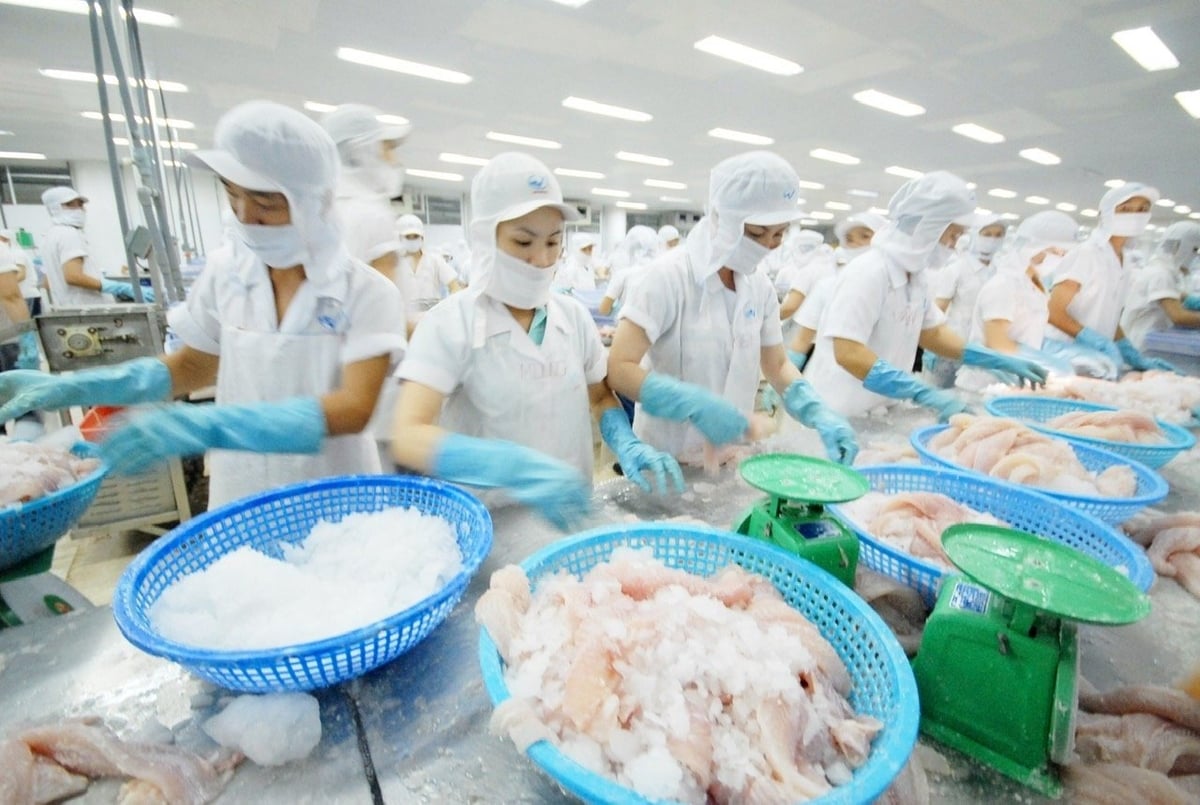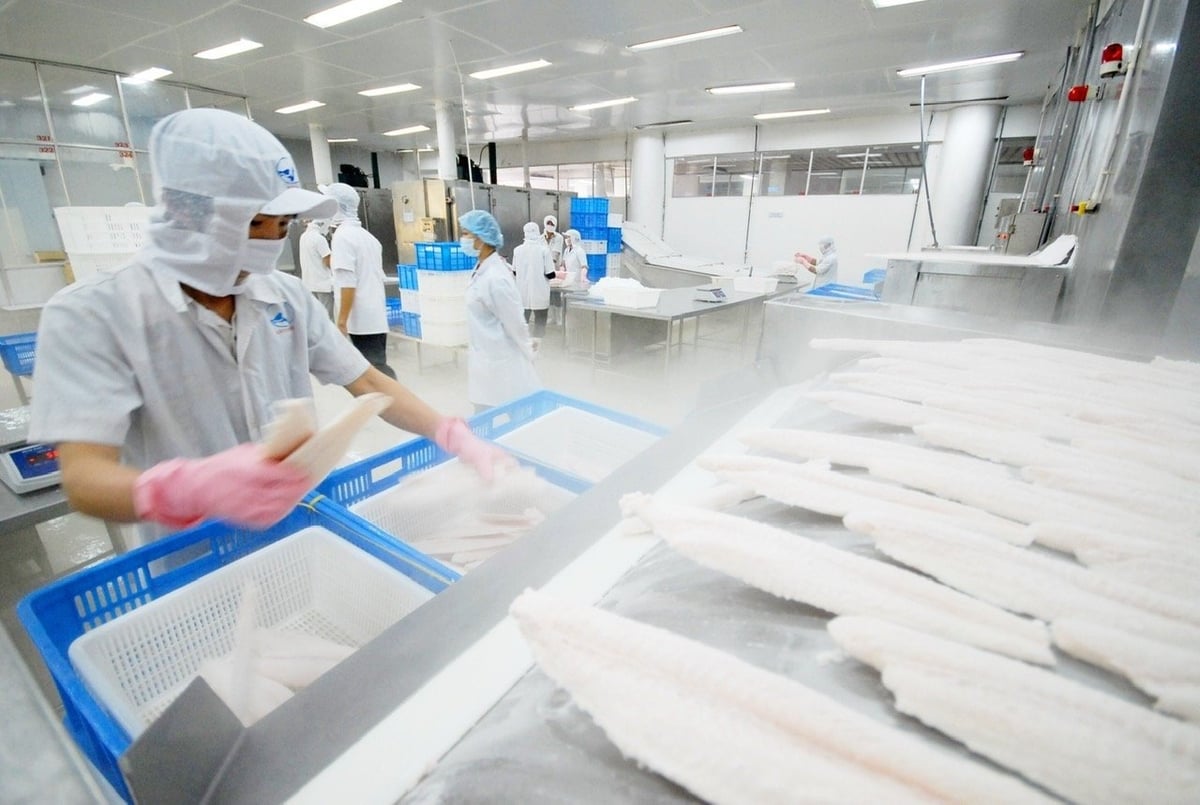December 5, 2025 | 08:28 GMT +7
December 5, 2025 | 08:28 GMT +7
Hotline: 0913.378.918
December 5, 2025 | 08:28 GMT +7
Hotline: 0913.378.918
According to Ms. To Thi Tuong Lan, Deputy Secretary General of the Vietnam Association of Seafood Exporters and Producers (VASEP), in July 2025, Vietnam's seafood export turnover reached USD 971 million, up 6.1% compared to the same period last year. Generally, in the first seven months of 2025, export value stood at USD 6.22 billion, marking a strong growth of 17.2%.
For pangasius alone, it has been a 'bright spot' in Vietnam's seafood export picture over the first seven months of 2025, with export turnover surpassing USD 1.2 billion, up 11.1% compared to the same period last year.

Vietnam's pangasius exports reached USD 1.2 billion in the first seven months of 2025, up 11.1% compared to the same period last year. Photo: Hong Tham.
A highlight in the 20th administrative review (POR20) was that eight major Vietnamese pangasius processing and exporting enterprises, including Vinh Hoan, were subject to a 0% anti-dumping duty rate. This outcome has helped restore confidence in the U.S. market.
However, Ms. Lan also expressed concerns that the results of POR22 (August 1, 2024–July 31, 2025) and POR23 (August 1, 2025–July 31, 2026) could bring higher duties, given that export prices during these two periods are not high, while many enterprises benefiting from low duty rates in recent PORs have participated in exports.
She warned that export enterprises must take greater responsibility, particularly small businesses that often assume that they will never be selected as mandatory respondents and therefore export their products at low prices. This approach not only negatively impacts the market but also poses significant risks of higher duty imposition, especially as the U.S. market is currently flooded with pangasius fillets.
The Deputy Secretary General of VASEP forecast that Vietnam's seafood exports in 2025 could reach USD 9–9.5 billion, with pangasius alone accounting for USD 2 billion.
Despite bright spots, Vietnam's pangasius exports still face considerable challenges and risks from macro factors such as trade conflicts, inflation, exchange rate volatility, and tariff policies (particularly as the U.S. is considering additional duties on multiple trading partners), all of which are creating a new cycle of fluctuations for the industry.
Against this backdrop, many export-driven sectors, including pangasius, are considering the "back-to-home" strategy. According to VASEP, domestic consumption remains relatively modest, accounting for only about 5–7% of total pangasius production. Most pangasius output is farmed and processed for export, while domestic consumption is largely limited to whole fish and pre-processed fillets, presented in monotonous forms with little investment in packaging or branding.
VASEP pointed out lessons from other countries in the region, showing that the domestic market should not be seen merely as a "backup plan" but can indeed serve as a pillar of stability if developed in the right direction.
For example, in Thailand, where tilapia farming is well developed, around 60% of production is consumed domestically thanks to government programs that integrate fish into meals at schools, hospitals, the military, and other public institutions. In India, with a population of 1.4 billion, freshwater fish serves as a key protein source, helping maintain stable production even during export slowdowns.

Lessons from regional countries show that the domestic market should not be regarded merely as a "backup plan" but can serve as a pillar of stability if developed in the right direction. Photo: Hong Tham.
Several major companies have already experimented with diversifying deep-processed products such as fish cakes, fish balls, and packaged noodle soup with pangasius, targeting younger consumers, students, workers, and collective kitchens. However, for the domestic market to truly become a "lifeline," stronger initiatives are needed, such as integrating pangasius into school nutrition programs, launching stimulus packages to boost seafood consumption, or implementing nationwide communication campaigns.
With the unpredictable fluctuations in export markets, relying solely on foreign channels could leave the pangasius industry vulnerable. Therefore, the domestic market is no longer just an option but a matter of survival for maintaining cash flow, sustaining production, protecting farmers, and securing jobs. It is time for Vietnam to recognize the domestic market as a real market, not merely a short-term solution when exports encounter difficulties but a "long-term stronghold" that builds resilience across the entire pangasius value chain.
On a recent flight from Vietnam to Thailand, I was surprised when the in-flight meal featured a serving of Vietnamese pangasius and basa rice. In midair, the familiar dish from the Mekong Delta appeared as a vivid testament to the global integration of Vietnamese seafood. From a domestically farmed fish species, pangasius has now risen to become a culinary ‘ambassador,’ present in the meals of millions of diners worldwide.
Translated by Thu Huyen

(VAN) Despite numerous challenges, Vietnam's key seafood products are maintaining strong momentum, setting the stage for full-year exports to potentially reach USD 11 billion.

(VAN) The signing of a protocol between Viet Nam and China on the export of fresh jackfruit represents a significant milestone in agricultural trade cooperation between the two countries.

(VAN) On November 27, the Ninh Binh Department of Agriculture and Environment and the Institute for Green Growth Research organized a training course on greenhouse gas inventory for businesses.

(VAN) China’s cooking oil is suddenly flooding into India. It all comes down to a soybean surplus that Beijing doesn’t quite know what to do with.

(VAN) An Giang promotes supply-demand connections, standardizes quality and builds value chains, creating a foundation for sustainable bird’s nest development and aiming to expand exports.
/2025/11/24/5339-4-nongnghiep-075331.jpg)
(VAN) Recently, the conference on 'Sustainable Fisheries Linkage Chain - Tilapia for Export' took place in Tien Hai commune, Hung Yen province.
/2025/11/21/4309-2-153400_128.jpg)
(VAN) Green and low-emission rice is paving the way for Vietnamese rice to enter high-end markets, marking the beginning of a transformation journey toward greening and elevating the national rice brand.